 When my friend and FNY correspondent Christina Wilkinson wrote a Governors Island overview in 2004, I thought it was the best one I had read until that time. The website it originally appeared on has folded since then, so I thought it would be a good time to reprint it here, along with some new photos taken in October 2010. The island has gradually become more visitor-friendly over the years and is on the brink of becoming one of NYC’s greatest tourist attractions. Its military ghosts, though, will never be completely exorcised.
When my friend and FNY correspondent Christina Wilkinson wrote a Governors Island overview in 2004, I thought it was the best one I had read until that time. The website it originally appeared on has folded since then, so I thought it would be a good time to reprint it here, along with some new photos taken in October 2010. The island has gradually become more visitor-friendly over the years and is on the brink of becoming one of NYC’s greatest tourist attractions. Its military ghosts, though, will never be completely exorcised.
Governors Island
At the confluence of the Hudson and East Rivers, in New York Harbor, sits Governors Island. Long a mystery to most New Yorkers, the Island served as the longest continuously active military post in the United States, from 1794 until 1997.
How this piece of land came to be known as “Governors Island”:
1524: Giovanni de Verrazano becomes first white man to see the Island, at the time, called “Pagganck” by the Indians, which means “Island of Nuts.” The nuts were from oak, hickory and chestnut trees.
1637: Wouter Van Twiller, the Director General of New Netherlands, bought Pagganck from the Indians for 2 ax heads, a string of beads, and a few nails. It was now called “Nooten” or “Nutten Eylandt” which is the Dutch translation of Pagganck.
1638: Van Twiller was sent back to the Netherlands and his purchase of the Island was annulled by the Director General and Council of New Amsterdam, thereby returning it to the public domain. It was then set aside as an estate for Dutch Governors.
1664: The English took over Nutten Eylandt as well as New Amsterdam.
1698: New York Assembly renames Nutten “The Governor’s Island”and sets aside the land for “the benefit and accommodation of His Majestie’s Governors for the time being.”
1732: Governor Crosby used Island as preserve for English Pheasants. In 1738, it was officially designated as such.
1776: The first submarine used for warfare, the Turtle, a one-man vehicle, was used in the Bay on September 6th in an attempt to sink the British ship, HMS Eagle. The attempt did not succeed, and the submarine was spotted. When the sub driver, Sgt. Ezra Lee, surfaced, he realized it was daybreak and he was a few hundred yards from Governors Island. To aid his escape, he created a diversion by releasing the bomb into open waters where it exploded harmlessly. The British then retreated.
1783: Reoccupation by the Americans, and Governors Island changes hands for the last time.
1794-1966: Served as Army Post
1842: Samuel Morse conducted the first overwater test of his telegraph between Manhattan’s Battery and Governors Island.
1909: Wilbur Wright conducts first military flight from the Island to Grant’s Tomb and back.
1966-1997: Served as Coast Guard Station
1985-present: Historic Landmarks under National Park Service, Dept of the Interior.
1997-2003: Island left in mothballs
2003: Island sold back to New York State for $1 by the Federal Government; historic areas declared National Monument by President George W. Bush.
In 2003, the historical parts of the Island were open to the public for the first time in the Island’s history. I arranged to take a free tour on Saturday, August 30th 2003, at 10am. I returned to the Island on July 6th, 2004 at 1pm. Many of the pictures on the following pages were taken during these visits.
Ferry service is the only way to get to and from Governors Island, from the Battery Maritime Building in Manhattan, which is next to the Staten Island Ferry Terminal.
Above: ventilation tower for the Brooklyn Battery Tunnel. Brooklyn is at the extreme left of the picture.
Coursen Ferry
The ferry Samuel S. Coursen makes the journey back and forth from the BMB to Governors Island. The ferry is named after Lt. Samuel S. Coursen, a Congressional Medal of Honor winner, who sacrificed his life for others during the Korean War.
Arrival
The ferry slip on Governors Island, also known as “Soissons Dock.” A plaque on the Ferry Waiting Room/Visitors Center, to the left, reads:
“SOISSONS DOCK
Commemorating the heroic participation of the 16th U.S. Infantry Regiment from Governors Island in the victorious attack against German forces near Soissons, France, July 18, 1918, in which action the regiment suffered 1,734 casualties, more than 57 percent of its total strength. Erected by the Military Order of the World Wars, New York Chapter.”
The Ferry Waiting Room/Visitors Center contains information about the Island, restrooms, and vending machines.
Fort Jay
Close-up of the replica of the War Dept. seal that sits atop the entrance to Fort Jay. Notice the eagle is now missing a wing, and the sword and one of the flags are also no longer there.
According to our guide, there is an Island legend about the missing wing. The story goes like this: In 1806, there was a prisoner in the fort who was working as a stonecutter. He noticed the damaged wing dangling precariously above the head of the commanding general’s daughter. He quickly sprung into action, ushered the young lady to safety, and bore the brunt of the falling stone on his back. For this, he was granted a full pardon, and was released from the Island. Of course, this legend cannot be true, because there were no prisoners on the Island in 1806. Furthermore, the photo below shows that the eagle’s wing was still intact in 1920.
The plaque on the left side of the fort’s front entrance reads:
“STUDENTS AND SOLDIERS OF FREEDOM
In keeping with the American tradition that men will defend freedom with both ideas and arms, this plaque is presented to Fort Jay by the Association of the Alumni of Columbia College to memorialize the fact that in 1794, students and faculty of Columbia worked with†shovel and barrows to erect this fort, named after John Jay, Columbia class of 1764, whose life exemplified the best traditions of free men. Erected May 13, 1922.”
The plaque on the left side of the fort’s front entrance reads:
“STUDENTS AND SOLDIERS OF FREEDOM
In keeping with the American tradition that men will defend freedom with both ideas and arms, this plaque is presented to Fort Jay by the Association of the Alumni of Columbia College to memorialize the fact that in 1794, students and faculty of Columbia worked with shovel and barrows to erect this fort, named after John Jay, Columbia class of 1764, whose life exemplified the best traditions of free men. Erected May 13, 1922.”
There was once a drawbridge in front of Fort Jay. The drawbridge was replaced by a stationary bridge many years ago, but the mechanism used to raise the drawbridge can still be found inside the entrance tunnel.
“The Governor’s Island Cavalry.” The rocking horses o the Ft. Jay lawn should perhaps be preserved as a reminder of the island’s former use in military family housing.
Aerial views of Fort Jay and the golf course just to its south. This is the only golf course in the borough of Manhattan.
A dry moat rims the edge of the star shaped, 5-pointed Fort Jay.
During the American Civil War, the armament of the fort was upgraded with nearly 50 10″ and 15″ Rodman cannons. Three 10″ and one 15″ Rodman cannons were retained at the fort’s east entrance gate and north overlook to Lower Manhattan when the remainder were scrapped in October 1942 for the war effort during World War II.
Nolan Park and Commanding Officers Quarters
One of the Governors Island Historic District’s most notable and handsome buildings is the Commanding Officers House. Its statuesque white columns are a focal point in the campus-like setting of Nolan Park. The prominent building (listed individually in the National Register of Historic Places) was constructed in 1843 in the Greek Revival style by the architect of the NY Arsenal in Central Park, headquarters of the Department of Parks & Recreation.
The house as it appears today was quite different in 1893 when the photo was taken. The symetrical form of the Greek Revival was changes in 1886 by the addition of a southern wing. Within the following 20 years, further changes gave the building its Colonial Revival appearance. Orignially, in place of the imposing white columns, lattice porch posts were in place as well as ornate railings, a peaked roof and ornamental aloe plantings out front! The familiar cannons [captured during the Spanish-American War] and central flower bed in front of the house were also added during a1936 WPA renovation which transformed the building to more or less its current appearance. Governors Island Blog
On December 7, 1988, President Ronald Reagan and [President-Elect] George H. W. Bush met with Soviet leader Mikhail Gorbachev on Governors Island, then the headquarters for the Coast Guard.
Documentation of the events that day remained secret for twenty years, but the release of both Soviet and American materials, analyzed and posted by the National Security Archive provides a vivid picture of the dramatic events that unfolded around the meeting. Furthermore, now that Governors Island is open to the public, including the Commanders House where the leaders met for lunch, it is now possible to reconstruct the historic events by matching the words of a declassified memorandum describing the lunch with images of the interiors of the house today. Walking off the Big Apple
Nolan Park, a grassy, lawned enclave along the island’s southeast edge adjoining the Commanding Officers House, is lined with handsome, yellow-sided buildings.
Governors Island (no apostrophe, officially) is named because it was home to several British governors in the pre-Revolutionary War era. This was their official residence, and the oldest surviving building on the island, built for Lord Cornbury in 1708. It has been renovated so many times that the exterior bears little resemblance to what must have been its original appearance. There is a legend that there was a tunnel built from this house to the dock so the British governor could make a quick escape from the island and invading Americans. No evidence of such a tunnel exists today.
The house to the right of the Governor’s House is called the “Dutch House” (left). This is not because Dutch settlers inhabited it, but because of the step-roof style of architecture, also called a “Dutch” roof.
At the west end of Nolan Park are the Chapel of St. Cornelius the Centurion and the now-decommissioned St. Mary Star of the Sea Catholic Chapel. The original St. Cornelius chapel was built in 1847 and became part of Trinity Church (Episcopal) in 1868. The chapel was razed after years of disrepair and the handsome new chapel constructed by Trinity Church in 1905.
Near both churches is the South Battery (below). Burt Bacharach played piano in the Officers’ Club here from 1950-1952 while serving in the Army.
A plaque here reads:
“1790 THE SOUTH BATTERY 1826
Erected during the War of 1812 to guard Buttermilk Channel. Used as a barracks for the Pipe and Drum Corps of the garrison from 1836 until the First Officers Mess was established here, June 30, 1879. Reorganized as the First Officers Club February 3, 1881. This tablet erected December 1, 1931 by the Veteran Corps of Artillery N.Y. and the General Society of the War of 1812.”
The smallest religious structure on the Island is the Jewish Temple, built after World War II. It sits near the Block House (left). The Block House was at one time the residence of Captain Ulysses S. Grant, who was stationed at Governors Island for a short time. This was known as the Officers Quarters prior to the Civil War. photo: The Masterpiece Next Door
A plaque nearby reads:
“JOHN PETER ZENGER
The renowned champion of the freedom of the press spent his first days in America on Governors Island. As a thirteen year-old boy, he arrived in New York in 1710 with thousands of refugees from the Palatinate, who were quartered for a time on this island. In 1735, as publisher of the New York Weekly Journal, he was acquitted of libel charges in the historic court trial, which marked the first major contribution to the cause of freedom of the press in America. Erected by First United States Army, 14 October 1963.”
(Governors Island was used as a quarantine station for new immigrants in the 1700’s.)
The homes on “Colonels’ Row” face the front of Liggett Hall (below), but when built in the post-Civil War era, they actually sat on the waterfront. Hay Road lined the southwestern perimeter of the Island, which at the time was half the size it is now. (Landfill from the excavation of the Lexington Avenue subway line in 1901 was responsible for the expansion of the Island to its current size.) The army built these homes to provide an incentive for learned men to join the service rather than venture into the business world, which was considered more prestigious at the time. A monument commemorates the 300th anniversary of the purchase of Governors Island from Native Americans, and includes a brief history of the Island up to 1937.
The giant army barracks (known as Liggett Hall or Building 400) were constructed across the center of Governors Island to prevent a public airport from being built there. It was once home to a Regiment of 1,375 soldiers, and when built in the 1920’s, was the longest building in the world and the largest constructed by the United States Army prior to the Pentagon. The hall is named for Lieutenant General Hunter Liggett (1857-1935) who commanded in the Spanish-American War and World War I.
The sign is leftover from when gym hours were on military time.
Early Bird Monument
Since the construction of Liggett Hall was supposedly an attempt to discourage airplane use on the Island, it is ironic that a monument to the Early Birds, the pioneers of military aviation, is found behind the building.
From Governors Island on September 29, 1909, Wilbur Wright piloted the first military flight, and the first American flight over water, which looped around the Statue of Liberty and landed safely back at the Island. On October 4, 1909, he piloted another successful flight from the Island, up to Grant’s Tomb, and back.
Another pioneer of aviation, Glenn H. Curtiss, made a successful flight from Albany to Governors Island on May 29, 1910, winning a $10,000 prize offered by Joseph Pulitzer’s New York World newspaper.
The bronze propeller was cast directly from one of the wooden propellers on the “aeroplane” used to to propel Wilbur Wright during his first military flight. The originals are in the Smithsonian Institution’s National Air & Space Museum in Washington, D.C.
There’s seemingly a monument at every bend in the road on Governors. Bertram Clayton and Merle B. Hay were among the first American casualties in WWI, and were from Governors Island.
Governors Island’s street signs, blue and white mounted perpendicularly (one of the few occasions this is seen in modern-day NYC), are a relic of the Coast Guard’s stewardship of the island. I wonder if they’ll have to be changed to the upper/lowercase Clearview font as per new federal mandates (as of 2010).
Castle Williams
At the entrance to Castle Williams, the sign to the left of the door says, “commenced 1807” and the sign to the right of the door says “compleated 1811.”
A sign on the fort reads:
“CASTLE WILLIAMS
With walls forty feet high and eight feet thick, this red sandstone bastion bristled with over one hundred cannons when it was completed in 1811. Named after its designer, Lieutenant Colonel Jonathan Williams, it has also been nicknamed the ìCheeseboxî because of its circular shape. Castle Williams, with its twin fort, Castle Clinton in the Battery, was built to guard the waterway between Governors Island and New York City. Together these forts provided such a formidable defense that the British fleet never attempted to attack New York City during the War of 1812. Today, it is under the jurisdiction of the United States Coast Guard. Plaque provided by the New York Community Trust, 1976.”
There was never a shot fired in anger from Castle Williams, but in 1966 when command was changed from the army to the coast guard, the cannons atop the fort were fired ceremoniously. The vibrations from the noise unexpectedly shattered all the windows. The Castle was used as a jail from the Civil War through 1966. Castle Williams held as many as 1,000 Confederate soldiers during the Civil War; several died here and are buried at Cypress Hills National Cemetery in Brooklyn. Walt Disney and Rocky Graziano were both imprisoned here at one point for being AWOL from the army. Several prisoners are said to have escaped from here and successfully swam to Brooklyn. Castle Williams is called a “castle” not because of its shape or because it housed royalty, but because it was built entirely of stone. Structures built of stone along with wood and other materials bear the name of “fort.”
Other Governors Island Sites
Comedians Tom and Dick Smothers were also born in the Post Hospital on Governors Island in 1937 and 1939 respectively. Their father, Major Thomas B. Smothers, was stationed on the Island during that time. Neal Adams, the Batman and Superman comic book artist, was born there in 1941 as well.
Surprisingly, at one time, Governors Island had its very own railroad. The G.I.R.R. was only 1-3/4 miles long (the shortest railroad line in the world), but it was completely equipped with 3 cars and an engine. It was one of the smallest railroads in the world. This picture is from 1917. There are no traces of the railroad on the Island today. It was scrapped in 1931. Courtesy Tom Clinard
Many of the Nolan Park and Colonels Row buildings featured exhibits from local artists such as Cicada by Johannah Herr. The parade grounds south of Fort Jay stage performances by the Trapeze School of New York.
Written by Christina Wilkinson in 2004; page updated October 3, 2010


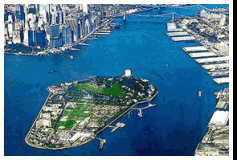
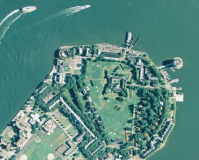
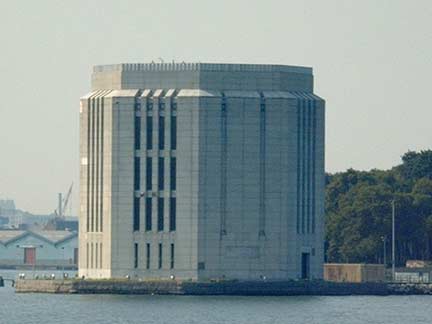





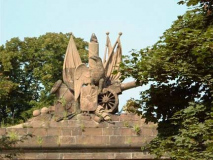
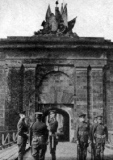
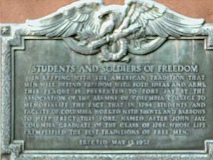
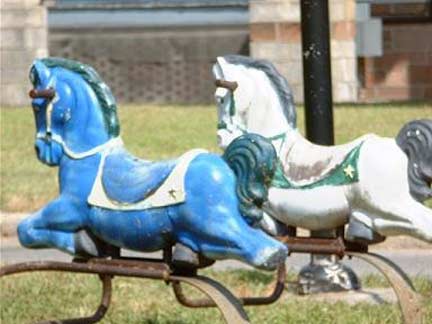

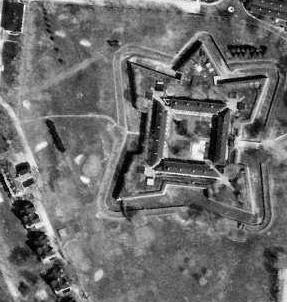
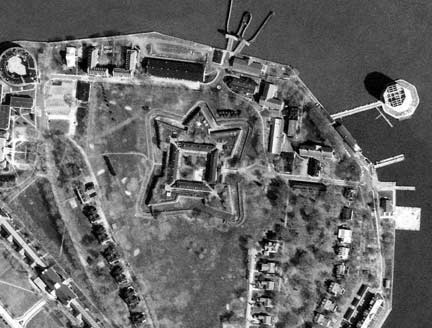
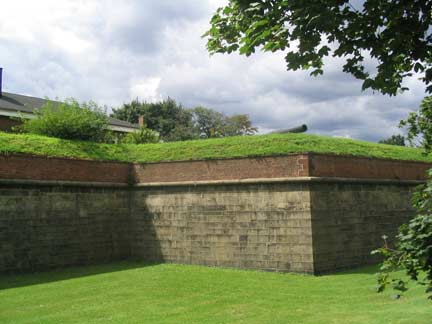
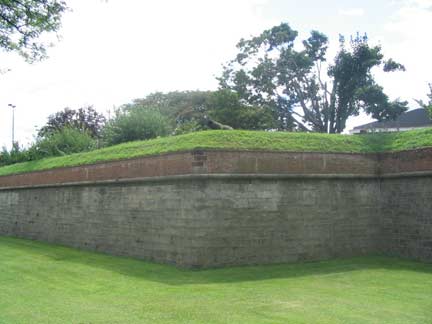
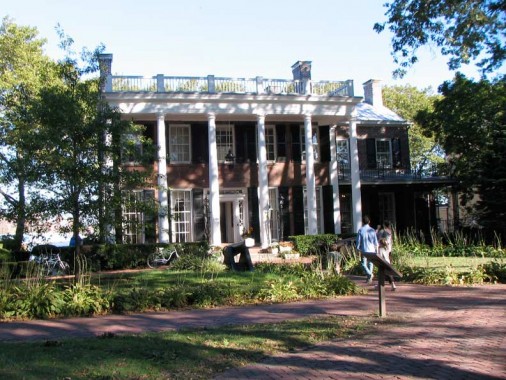

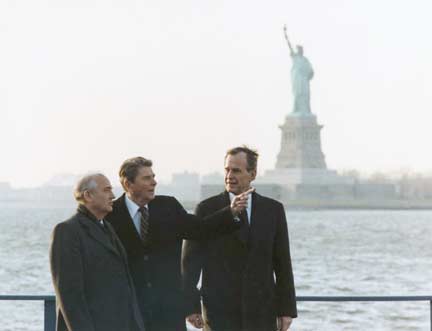


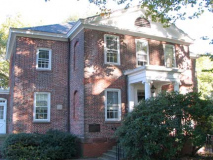
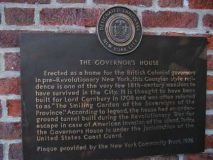
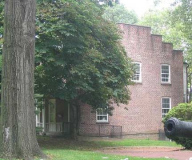
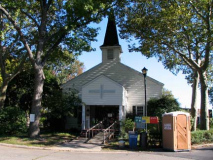
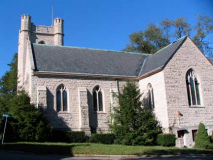
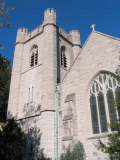
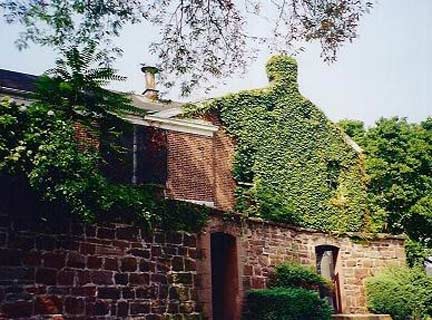

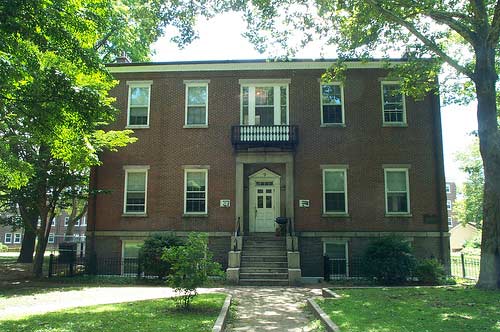
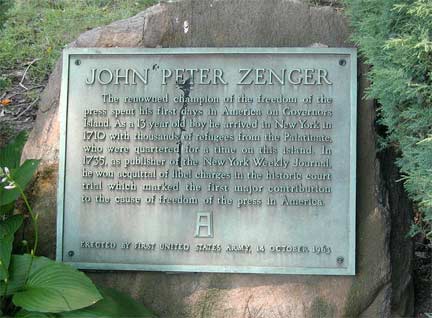

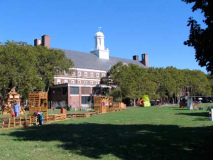
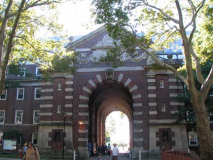
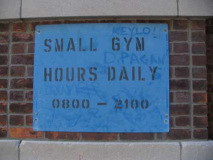
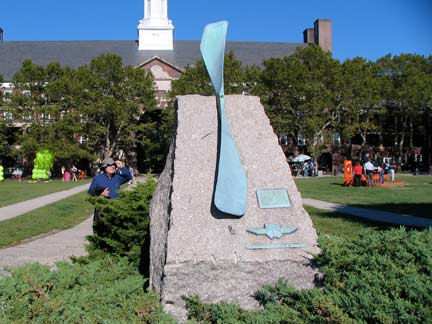

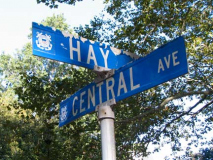
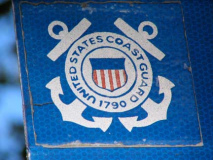
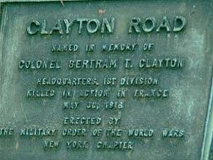
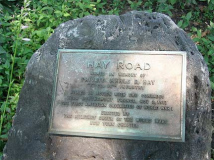
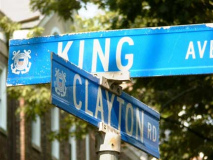
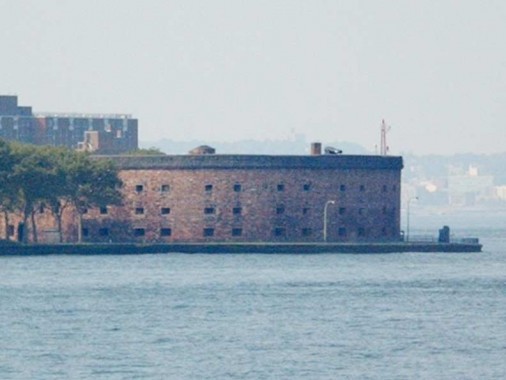
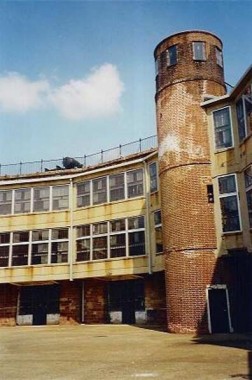


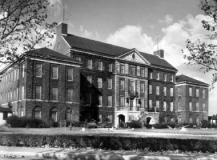
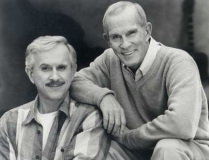

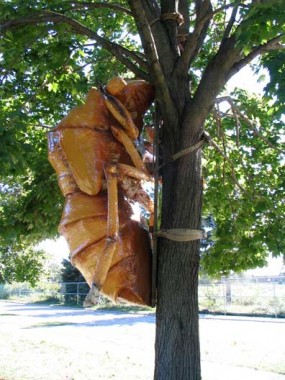
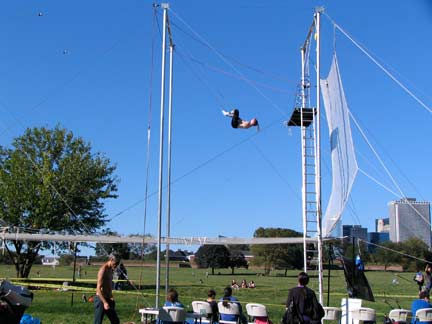
36 comments
My friend Capt Mike Garvin former Captain of the Ferry passed away Jan 9. 2103
http://www.flickr.com/photos/10151790@N06/8372257708/
You wrote that “Governors Island (no apostrophe, officially) is named because it was home to several British governors in the pre-Revolutionary War era. This was their official residence, and the oldest surviving building on the island, built for Lord Cornbury in 1708.” I think you’re getting that information from the plaque on the side of the building. However, a sign in front of the building states: “The Governor’s House was constructed in 1813 as a guardhouse for the island. . . . The name ‘Governors House’ is a misnomer as no New York State governor ever occupied the building. . . . The house may have been called ‘The Governor’s House’ due to its proximity to the location of the original English colonial governor’s residence, which no longer survives.”
“Walt Disney and Rocky Graziano were both imprisoned here at one point for being AWOL from the army.”
Walt Disney was never in the military, so he couldn’t have been held on the island for being AWOL.
Dear Sir or Madam,
My name is Philip Whitehorne Nelson and reside at
7119 Shore Road, Apt. 1K
Brooklyn, N.Y. 11209
(718) 680 – 2596.
I was born at Fort Jay, Governors Island, October 3, 1941.
My father was Lt. Harold C. Nelson and my mother Irene W. Nelson.
Can you afford me any information available pertaining to my birth and the
time of stay there?
Thank you for any assistance in this matter.
Hello,
Could you please tell me when the yellow houses were built in Nolan Park and who lived there?
Thank you.
I am researching the history of house 5B (a yellow and white house in Nolan Park) for an art installation project. Does anyone have any information or sources on the house and the families who lived there?
We lived in Quarters 5A, which is in the same building, from 1989-1991. The original quarters were built in 1854, and an addition was added in the 1930’s. I was the Coast Guard captain in charge of the Legal Department. My office was in Building 25 next to the Governor’s House at the north end of the park. The commander of the support center (base commanding officer) lived in that house.
Thank you so much for providing such a rich informative lesson on my birth place. (U.S. Army Hospital, Fort Jay, NY. in 1957).
I also was born at Fort Jay in 1957 and appreciate the rich information.
My brother Ernest R. Johnson and my brother in law, Leo Vogelien, we both stationed on Governors Island frGovernors Island during WWII? Are there maps of the island of that time?
I visited them at Fort Jay when I was 12 years old.
Any relation to the Ernest Johnson who may have lived at Strawtown Road, West Nyack? Wife Antoinette, children William and Linda?
I have found a Congressional hearing report from March 5, 1936 on the possible erection of an airport on Governors Island. My grandfather worked for John McSwain , of South Carolina, chair of the committee on military affairs.
They go on about possible attacks, communists handing out pamphlets on Broadway, the water supply and the logistics of the flight patterns. Some humor..NYC had a 3 day supply of food in case of disasters…located where?
The Governor’s Island Airfield was actually existed but evidently closed at some point between 1924-29
in the 1950s the U.S. Army established a grass landing strip on the island. The Governor’s Island AAF was evidently closed (for reasons unknown) at some point between 1962-65
[…] ghosts. Yes! It’s been rumored that parts of the island are haunted—especially the historic Nolan Park area. It’s here that one of the world’s only holographic museums has set up shop for the […]
I was stationed on Govenors Island from June 1973 to December 24th 1975. What a beutiful place.In your article you refer to The Congressional Medal Of Honor.There is NO such medal.It is simply The Medal Of Honor as congress has no say in who is elected (thank God for that)
Sorry my friend it is the Congressional Medal of
Honor. It is awarded by Congress.
Who is Nolan Park named after? My great-grandfather worked as a caretaker on Governors Island in the late 1800’s. His last name was Nolan. I’m wondering if there is any connection. Obviously, the park is not named after him…..but maybe he was related.
Dennis E. Nolan
Major General
Commander of
The United States First Army
Governors Island, 1933-1936
https://www.hmdb.org/m.asp?m=147641
The history of the Palatine emigration 1710 is a dramatic emigration story. 3,000 beleagured German families landed on Nutten Island (first ship on June 13 , 1710), of the 3,000 who set out many had died. When they landed 1/3 of them were extremely ill and many more died on the island. They were quarantined on Nutten Island for fear they would spread diseases. (New York at the time only had a population of 6,000.) There they lived in British military tents until they could be transported up the Hudson to serve as slave labor for an ill-conceived project to harvest tar and resin from pine trees (for the British navy). Thier suffering, begun early in in 1709 in Rotterdam and London, continued through November 1712 when they were told to fend for themselves, that the project was over. For an excellent review of Palatine history consult: “Becoming German, The 1709 Palatine Migration to New York.” by Philip Otterness. How nice it would be to place a plaque on Nutten Island in memory of these brave people.”
The best article I have ever read on the Island. I was stationed there in 86 to 89
btw Walt Disney was never imprisoned here for being AWOL from the army. He was never in the army lol Disney attempted to join the United States Army to fight against the Germans, but he was rejected for being too young.
I fondly remember my time on Governors Island from September 1956 – January 1959, when my father served in the U.S. Army. We lived in buildings T-226, T-203, and finally in 12-I. Quite a few moves for one station. That was Army life.
I am interested in Nutten Island because my ancestor, Maria Warenbaur, and her four children landed on the island betweem June and August of 1710. They arrived on ten ships which were carrying Huguenots from London to NY. Because of the diseases on board the ship they were forced to live in tents on Nutten Island for five months before being allowed to continue on up the Hudson River.
According to literature several hundreds of the 1709-1710 Palatine immigrants were buried on the island. Can anybody tell me where they are buried?
I lived on Governors Island as an Enlisted Coast Guardsman in the late 1970’s. I remember it as a good place to live. Close enough to Manhattan to visit but far enough away not to worry about crime. I was stationed on the CGC Gallatin and then later on the island itself.
My wife and I married in the St. Cornelius Chapel, (back when they the regiment flags adorning it), and it was a good place to have a family.
Donald G. Hands
I was born on Governors Island in 1940. My father delivered me at the hospital! He also delivered the Smothers Brothers. After he commanded a field hospital during WW II, he was posted to Governors Island again.
I went to elementary school there and attended Mass at Our Lady Star of the Sea chapel. My family often went to the Officer’s Club for dinner or other functions.My brother would come home from school in the summer and worked as a lifeguard at the YMCA swimming pool.
I am thrilled with these pictures; they bring back so many wonderful memories.
I was born at Ft. Jay Army hospital on July 10, 1956. I grew up in The Bronx.
I and my family lived on Governors Island for three years until the GSA sold it to NYC. It was a truly magical place to live and raise kids.
We are so glad that NYC has done such a great job in making it a park.
Reed
Btw – there were many famous criminals held in secure custody on the Island as they had their Federal trials in the Federal courthouse on Manhattan.
I am researching my great grandmother’s immigration records and on her naturalization application (Jun 1956) she has listed as her address 12-11-5 Govenors Island, New York, Ny. She was recently married to my great grand father whom I think was in the army at the time. Can anyone provide insight as to which building that may be and what clues it may provide? Its all so fascinating!
I am researching my grandmother’s immigration records and on her naturalization application (Jun 1956) she has listed as her address 12-11-5 Govenors Island, New York, Ny. She was recently married to my grand father whom I think was in the army at the time. Can anyone provide insight as to which building that may be and what clues it may provide? Its all so fascinating!
i was there from 63 to 65 it was a great place to be. would it be to much to ask, who was all the commanders of ft jay [list of them]
Stationed here Feb 62 to Nov 63. Dental Assistant. Inspired a section of my book “Sunrise Across
America,” where a framed fugitive TV anchorman re-visits Fort Jay. As a show biz type, I had a
great tour seeing Broadway shows and meeting my wife. Some of those experiences are in our
movie, “There’s Danger in Romance” where a romance novel publisher falls in love with an
author even though, ironically, she has no romantic life until they meet.
My dad George Bryant served in Coast Guard on base in 1967 when I was born I live on the island for 9 months till he was transferred to Norfolk Va.
I lived on Governors Island from 1961-1963 as a child aged 10-12 after returning from Tachikawa AFB in Tokyo, Japan. My father was a U.S. Army Captain at the time (he retired as a full Colonel). I have great memories of my brief time there – I could see the harbor and the Statue of Liberty from my bedroom, so I would watch all the great ocean liners come into the harbor – the SS United Sates, Queen Mary, The France, etc. I would set my alarm if I knew they were arriving in the middle of the night just to watch them glide in under the lights of NYC and the tugboats spraying their welcome. I joined the Girl Scouts there and had my confirmation at the Trinity Church. From there I moved to Ft. Totten in Queens – another great place to live as a child/teen), then we were stationed at Camp de Loges in Paris, France, and then Manzarali Station outside of Ankara, Turkey. What a life! I’m glad Governors Island was part of it! Thanks for a great post!
I was in the US Army reserve in a strategic intelligence research and analysis unit (434th SIRA) from 1957 – 1963. we met on the island and I believe it was the HQ for First
Army at that time. But the fact that nowhere in the great write up above is that mentioned. Is my memory faulty, or am I simply confused? Can anyone clarify?
I was in the Coast Guard unit that took possession of Governors Island in 1966; on the crews that remodeled the ferry terminal then drove the pilings for the south island pier. Left in 1969, then back in 1975 to 1978 stationed at the Training Center. Anybody out there from those years?